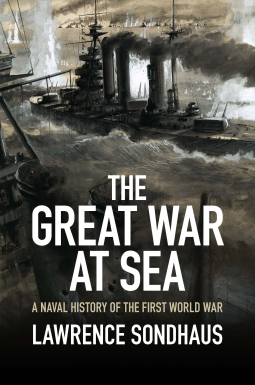
The Great War at Sea
A Naval History of the First World War
by Lawrence Sondhaus
This title was previously available on NetGalley and is now archived.
Send NetGalley books directly to your Kindle or Kindle app
1
To read on a Kindle or Kindle app, please add kindle@netgalley.com as an approved email address to receive files in your Amazon account. Click here for step-by-step instructions.
2
Also find your Kindle email address within your Amazon account, and enter it here.
Pub Date Sep 30 2014 | Archive Date Sep 01 2014
Description
This is a major new naval history of the First World War which reveals the decisive contribution of the war at sea to Allied victory. In a truly global account, Lawrence Sondhaus traces the course of the campaigns in the North Sea, Atlantic, Adriatic, Baltic and Mediterranean and examines the role of critical innovations in the design and performance of ships, wireless communication and firepower. He charts how Allied supremacy led the Central Powers to attempt to revolutionize naval warfare by pursuing unrestricted submarine warfare, ultimately prompting the United States to enter the war. Victory against the submarine challenge, following their earlier success in sweeping the seas of German cruisers and other surface raiders, left the Allies free to use the world's sea lanes to transport supplies and troops to Europe from overseas territories, and eventually from the United States, which proved a decisive factor in their ultimate victory.
Advance Praise
No Advance Praise Available
No Advance Praise Available
Marketing Plan
Advance reading copies available
National print, broadcast, digital media campaign
Social media promotion on Facebook and Twitter
Advance reading copies available
National print, broadcast, digital media campaign
Social media promotion on Facebook and Twitter
Available Editions
| EDITION | Hardcover |
| ISBN | 9781107036901 |
| PRICE | $35.00 (USD) |
Average rating from 5 members
Featured Reviews
 Joseph S, Reviewer
Joseph S, Reviewer
“There is something wrong with our bloody ships today.” Vice Admiral David Beatty to Captain Ernle Chatfield at the Battle of Jutland
H.H. Asquith British Prime Minister 1906-1916: “with deference to our soldiers, this war has been won with sea power.”
The Great War at Sea: A Naval History of the First World War by Lawrence Sondhaus is a detailed look at how sea power played a role in WWI. Sondhaus is an associate professor in the department of history and political science at the University of Indianapolis. He is the author of Naval Warfare, 1815–1914 ; Franz Conrad von Hötzendorf: Architect of the Apocalypse ; Preparing for Weltpolitik: German Sea Power before the Tirpitz Era ; and two volumes on the Austrian navy.
For many, myself included, World War I was usually covered in the History of the 20th Century or a similar class. My recollection was Germany invaded France through Belgium and the rest of Europe fell into war and a system of trenches. America entered the war to end the slaughterhouse that Europe had become. The Western front was covered in some detail. The Eastern front, which was far more active, was for the most part ignored. Naval warfare consisted of the Battle of Jutland and Germany’s unsuccessful submarine warfare. Over the years I have learned a great deal more of the war that formed the 20th Century. Naval warfare has always been limited in coverage with the exception of Jutland. Sondhaus presents a wealth of data on the effects of naval power on the outcome of the war.
Prior to WWI, the world was recognizing the importance of a modern navy. Navy’s could easily change the outcome of the war. Japan’s navy humiliated the Russian navy twice in the decade before the Great War. Britain used naval power to secure trade routes for her Empire. America needed a navy, to support its claims in Latin America and the Philippines. Naval power meant power projection. Militarily, Germany and Britain were opposites. Britain had a strong navy and a weak army; Germany the strong army, fresh from the defeat of France in 1871, and a weak navy. Germany began a naval build up before the war with the intention of equalling Britain.
Technology lead to changes in ship designs and much larger capital ships. Ships moved from burning coal to oil burning oil. Systems were designed for ranging and firing at targets, however even in the best situations accuracy was about 4% -- four out of one hundred fired would actually hit the target. Torpedoes came into play with longer ranges,up to 5,000 feet. In an impressive growth spurt naval guns now could fire a 19,000 feet. Perhaps the most the most important bit of technology was wireless communications. From humble beginnings of 50 meters range grew to almost half a world away. Communications allowed better control of navies.
On of the earliest naval battles was the running battle between HMAS Australia and von Spree’s squadron of German ships across the Pacific. Spree was intent on doing as much damage to the Allies as he could on his way back to Germany. Spree waged a running attack against the Allies until he was defeated at the Falkland Islands in December 1914. Spree’s run lasted 15,000 miles-- unheard of in steam powered days.
There was warfare in the Mediterranean Sea, though limited. Austria-Hungary’s navy was trapped by the French and British navy. Austria-Hungary did score a first in naval history on September 15th, 1916 when a naval seaplane sunk the french submarine Foucault. Unlike surface ships where guess work played a large role in dropping depth charges, from the air, a low running submarine gave a visible silhouette and an easy target. The problem was with the accuracy of dropping bombs.
The sinking of the Lusitania is usually credited with bringing the United States into World War I. The US did not declare war on Germany until two years later. The Lusitania, did however, change US opinion of the war. Early on England and it’s strict interpretation of wartime contraband prevent almost all trade, including cotton, affecting United State’s rights as a neutral. Unrestricted submarine warfare did turn public opinion from German support to Allied support.
The Great War at Sea is the most comprehensive account of the power and projection of naval forces in WWI. Sondhaus gives details of many events that usually do not make it into the general history books, or even other books on the First World War. There is a chapter devoted to the Russian Navy in the Russian Revolution, several chapters to the naval build up before the war, the war in the Mediterranean, detailed accounts of Germany’s main efforts in submarine warfare, and of course the Battle of Jutland and who won, if anyone. A very detailed and well cited work of history recommended for anyone want to know more about naval history or wanting a more complete history of WWI.
Review also posted on Goodreads https://www.goodreads.com/review/show/1001700342
 zeb k, Reviewer
zeb k, Reviewer
This is the most comprehensive history of the naval conflicts during the First World War that you can read. Every Navy that was involved in the war is detailed down to the number and type of ships. Every engagement between the different navies is detailed as to ships, strategy and outcome.
Sondhaus begins by describing the ship building programs that were in place prior to the war and the types and numbers of each Navy just prior to the War. He then goes on to discuss the ships that were lost and their replacements during the war. Most importantly he discussed the effect of the Navies on each other even when they did nothing but sit in port.
In great detail he goes over the effects of the two periods of German “unlimited” submarine warfare and how they affected the neutral nations and the economies of both the neutrals and combatants. Though he mostly focuses on the British and German fleets, he discussed all the major navies including the Japanese and Australian take-over of the German island colonies in the Pacific.
For me, the details related to the German High Seas Fleet and the British Great Fleet, and the chess games that played out during the war was the most interesting. Sondhaus gives exhaustive detail to the Battle of Jutland and to the Allied push before and after the landings at Gallipoli.
Most impressive is the recording of the mutinies that occurred in the Navies of the Central Powers as the war neared its’ end. Except for Great Britain, the four other empires involved in the war all ceased to exist after the time of the Armistice. Three of the Empires were broke up and the Germans lost over 1/3 of their land area.
After the Armistice, the German Navy was taken to the Scottish Naval Base at Scapa Flow. When it was announced, that as part of the Versailles Treaty, the ships would be divided up among the victors, the remaining sailors ran-up their Battle Flags and scuttled all of their ships.
Well written and documented.
Zeb Kantrowitz zworstblog.blogspot.com
 Reviewer 142808
Reviewer 142808
The First World War was mainly fought on land. However, navy played a key role in the outcome of the war. If you are a history buff, The Great War At Sea will give you a detailed account of what the navy’s role was in the First World War. The author explores and presents a complex picture of how the navies of different countries prepared for the war and the progress of naval technology during this time.
The Great War At Sea begins with a background on the naval happenings in the European countries. The expanding British navy, shifting alliances, and Germany’s entry resulting in the naval arms race sets the backdrop of years before the war broke out. The author shifts between dates and timelines to point out the cause and effect of different decisions and gives a complete picture of where each country stood in the European naval race. Later, the author highlights the technological development that this arms race triggered in wireless communication as well as in naval guns.
Although the book is about developments in the navy and naval capabilities of different European nations, the author also covers different war strategies and naval maneuvers in great detail. The book covers everything related to naval warfare: its role, strategic importance, and the technology. But the book might seem a bit daunting to readers who want to read just to get acquainted with the topic. I wouldn’t say that The Great War At Sea is an easy read that you can flip through. The book demands you complete attention, if you want to understand the role of navy in the conflict.
History students and other associated to the subject will get to know a lot as the author’s years of study and expertise clearly reflects in the content of the book.
Review also posted on Amazon.com and Goodreads.




